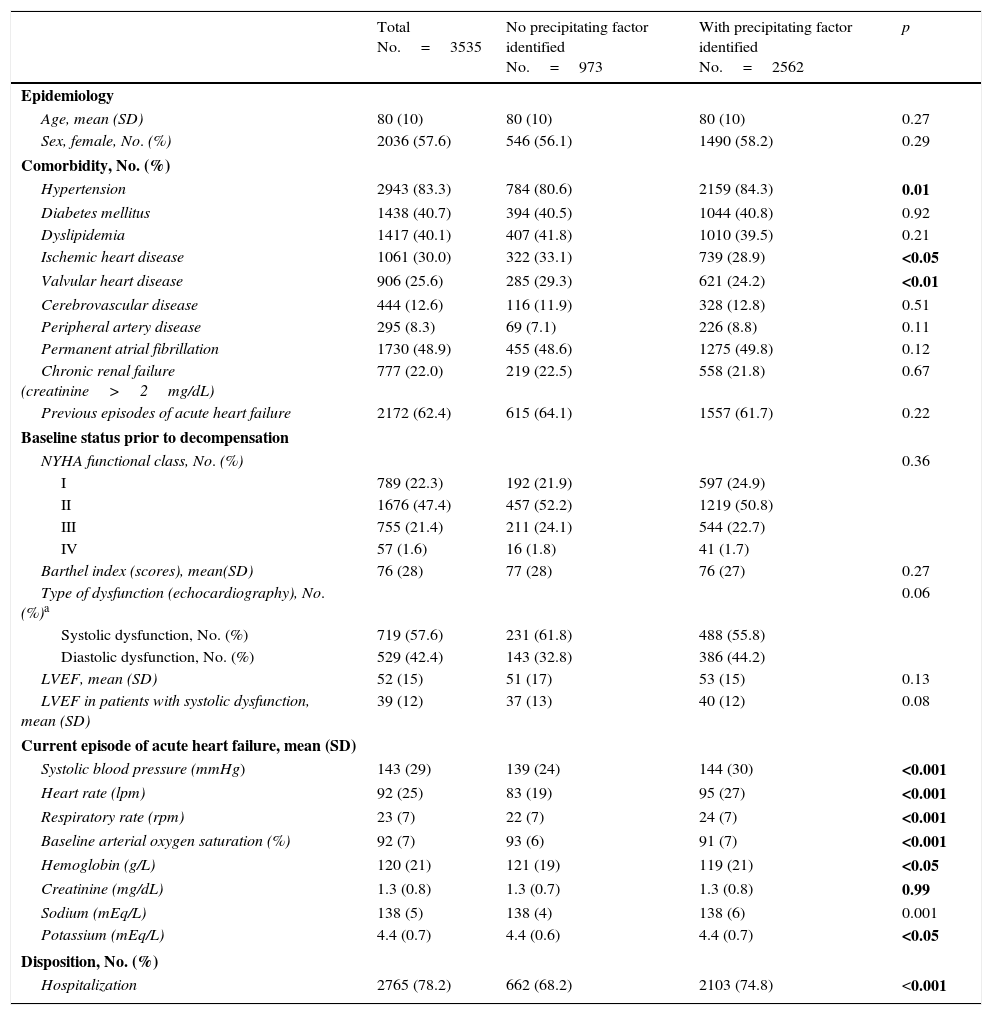To evaluate the precipitating factors (PF) associated with acute heart failure and their association with medium-term prognosis.
Patients and methodsMultipurpose prospective study from the EAHFE Registry. We included as PF: infection, rapid atrial fibrillation (RAF), anemia, hypertensive crisis, non-adherence to diet or drug therapy and non-ST-segment-elevation acute coronary syndrome (NSTEACS). Patients without PF were control group. Hazard ratios (HR) crudes and adjusted for reconsultations and mortality at 90 days were calculated.
Results3535 patients were included: 28% without and 72% with PF. Patients with RAF (HR 0.67; 95% CI 0.50–0.89) and hypertensive crisis (HR 0.45; 95% CI 0.28–0.72) had less mortality and patients with NSTEACS (HR 1.79; 95% CI 1.19–2.70) had more mortality. Reconsultation was fewer in patients with infection (HR 0.74; 95% CI 0.64–0.85), RAF (HR 0.69; 95% CI 0.58–0.83) and hypertensive crisis (HR 0.71; 95% CI 0.55–0.91). These differences were maintained in all the adjusted models except for hypertensive crisis.
ConclusionsOne PF is identified in 3 out of 4 patients and it may influence medium-term prognosis. At 90 days, NSTEACS and RAF were associated with more and less mortality respectively, and RAF and infection with less probability of reconsultation.
Evaluar los factores precipitantes (FP) asociados a los episodios de insuficiencia cardiaca aguda y si se asocian con el pronóstico a medio plazo.
Pacientes y métodosEstudio multipropósito prospectivo de la cohorte EAHFE. Como FP se incluyeron: infección, fibrilación auricular rápida (FAR), anemia, urgencia hipertensiva, trasgresión terapéutica-dietética, y síndrome coronario agudo sin elevación del ST (SCASEST). Como grupo control se escogió a los pacientes sin FP reconocido. Se calcularon las hazard ratio (HR) crudas y ajustadas para la reconsulta a urgencias y la mortalidad por cualquier causa a 90 días.
ResultadosSe incluyeron 3.535 pacientes, el 72% con FP. Respecto a los pacientes sin FP reconocido, presentaron menor mortalidad los pacientes con FAR (HR 0,67; IC95% 0,50-0,89) y urgencia hipertensiva (HR 0,45; IC95% 0,28-0,72) y mayor los pacientes con SCASEST (HR 1,79; IC95% 1,19-2,70). La reconsulta fue menor en los pacientes con infección (HR 0,74; IC95% 0,64-0,85), FAR (HR 0,69; IC95% 0,58-0,83) y urgencia hipertensiva (HR 0,71; IC95% 0,55-0,91). Estas diferencias persistieron en todos los modelos ajustados, excepto las relacionadas con la urgencia hipertensiva.
ConclusiónEn 3 de cada 4 pacientes con insuficiencia cardiaca aguda se identifica un FP, pudiendo este influir en los resultados a medio plazo. El SCASEST y la FAR se asociaron a una mayor y menor mortalidad a 90 días respectivamente, y la FAR y la infección a una menor probabilidad de reconsulta a 90 días.








